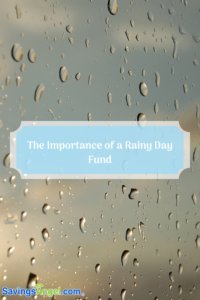The Importance of a Rainy Day Fund

We’ve talked a lot about the importance of setting aside money in savings and an emergency fund. You’re probably thinking that rainy day funds and emergency funds are the same things. In truth, these savings funds have some key differences between them that highlight the importance of having both. Let’s discuss those differences and why you should have separate funds for each.
What are the Differences?
The key differences between a rainy day fund and an emergency fund lie in how much is needed in each and what they are used for. An emergency fund should have around 6 months worth of expenses saved in it so that in times of financial hardship, you have some time where your expenses are paid for before you run out of funds. A rainy day fund is a bit smaller and is meant to be used for incidentals such as a car repair, emergency room trip, and more. It shouldn’t be massive and you should always put more into your emergency fund. That being said, a rainy day fund is invaluable, especially since you want to avoid pulling from your emergency fund when incidentals do arise.
How Much Should You Set Aside?
There are no hard and fast rules for rainy day funds, however, a couple thousand dollars is a good goal to reach regarding the size of your rainy day fund. Set aside a small amount every month that you can put into your rainy day fund and make sure you’re still putting money into your emergency fund.
Building out your rainy day fund can take time, especially if incidentals arise as you are doing so. Don’t let these instances discourage you; that’s what a rainy day fund is for!
How To Build on Your Rainy Day Fund
As I said, always put what you can into the fund each month. When the time comes where you need to use it, spend what you must for your incidental by pulling from your rainy day fund. After that, the next time you go to add to it, consider adding a bit more than usual to more quickly recoup what you spent from savings. It still may take a few months to totally make up for that expenditure, but the more quickly you recover your rainy day fund, the better off you’ll be.
While an emergency fund is vital and important, rainy day funds often go overlooked and not talked about as much. If you want to maintain your emergency fund and not deplete it when you have no other choice, establish a rainy day fund. It protects your budget and your emergency fund from expensive incidentals.


